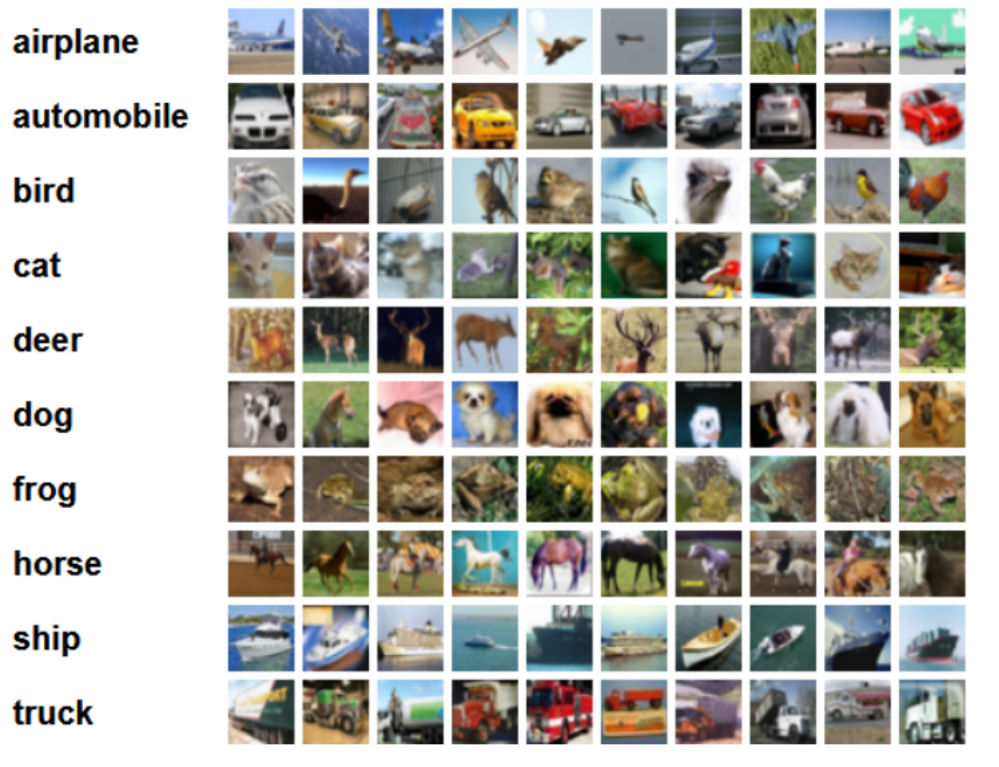CIFAR-10数据集图像分类【PCA+基于最小错误率的贝叶斯决策】
CIFAR-10和CIFAR-100均是带有标签的数据集,都出自于规模更大的一个数据集,他有八千万张小图片。而本次实验采用CIFAR-10数据集,该数据集共有60000张彩色图像,这些图像是32*32,分为10个类,每类6000张图。这里面有50000张用于训练,构成了5个训练批,每一批10000张图;另外10000用于测试,单独构成一批。测试批的数据里,取自10类中的每一类,每一类随机取1000张。抽剩下的就随机排列组成了训练批。注意一个训练批中的各类图像并不一定数量相同,总的来看训练批,每一类都有5000张图。
下面这幅图就是列举了10各类,每一类展示了随机的10张图片:

我的数据集一共有三个文件,分别是训练集train_data,测试集test_data以及标签名称labels_name,而标签名称中共有5个类,‘airplane‘, 'automobile‘, 'bird‘, 'cat‘, 'deer’.我现在准备对前三类‘airplane‘, ’automobile‘, ’bird‘,(即标签为1, 2, 3的数据 )进行分类。
经过之前大量测试,得到在累计方差贡献率为0.79时,基于最小错误率的贝叶斯决策用于图像分类最佳,以下为代码:
#CIFAR-10数据集:包含60000个32*32的彩色图像,共10类,每类6000个彩色图像。有50000个训练图像和10000个测试图像。
import scipy.io
train_data=scipy.io.loadmat("F:\\模式识别\\最小错误率的贝叶斯决策进行图像分类\\data\\train_data.mat")
print (type(train_data))
print (train_data.keys())
print (train_data.values())
print (len(train_data['Data']))
#单张图片的数据向量长度:32X32X3=3072
#内存占用量=3072*4*9968=116M 假定一个整数占用4个字节
print (len(train_data['Data'][0]))
print (train_data)
x = train_data['Data']
y = train_data['Label']
print (y)
print (len(y))
print (y.shape)
print (y.flatten().shape)
#labels_name:共5个标签,分别为airplane、automobile、bird、cat、deer
import scipy.io
labels_name=scipy.io.loadmat("F:\\模式识别\\最小错误率的贝叶斯决策进行图像分类\\data\\labels_name.mat")
print (type(labels_name))
print (labels_name)
print (len(labels_name))
#test_data:共5000个图像,5类,每类1000个图像
import scipy.io
test_data=scipy.io.loadmat("F:\\模式识别\\最小错误率的贝叶斯决策进行图像分类\\data\\test_data.mat")
print (test_data['Label'])
print (test_data['Data'])
print (len(test_data['Label']))
datatest = test_data['Data']
labeltest = test_data['Label']
print (datatest.shape)
print (labeltest.shape)
test_index=[]
for i in range(len(labeltest)):
if labeltest[i]==1:
test_index.append(i)
elif labeltest[i]==2:
test_index.append(i)
elif labeltest[i]==3:
test_index.append(i)
#print (test_index)
labeltest=test_data['Label'][:3000]
#print (labeltest)
import matplotlib.pyplot as plt
from mpl_toolkits.mplot3d import Axes3D
print (x)
print (x.shape)
print (type(x))
from sklearn.discriminant_analysis import LinearDiscriminantAnalysis
from sklearn.decomposition import PCA
pca=PCA(n_components=0.79)
#训练模型
pca.fit(x)
x_new=pca.transform(x)
print("降维后各主成分的累计方差贡献率:",pca.explained_variance_ratio_)
print("降维后主成分的个数:",pca.n_components_)
print (x_new)
index_1=[]
index_2=[]
index_3=[]
index_num=[]
for i in range(len(y)):
if y[i]==1:
index_1.append(i)
elif y[i]==2:
index_2.append(i)
elif y[i]==3:
index_3.append(i)
index_num=[len(index_1),len(index_2),len(index_3)]
print(len(index_1))
print(len(index_2))
print(len(index_3))
print (index_num)
import numpy as np
class1_feature=[]
class2_feature=[]
class3_feature=[]
#index_1
for i in index_1:
class1_feature.append(x_new[i])
print (len(class1_feature))
for i in index_2:
class2_feature.append(x_new[i])
print (len(class2_feature))
for i in index_3:
class3_feature.append(x_new[i])
print (len(class3_feature))
#计算第一类的类条件概率密度函数的参数
class1_feature=np.mat(class1_feature)
print (class1_feature.shape)
miu1=[]
sigma1=[]
for i in range(30):
miu=class1_feature[:,i].sum()/len(index_1)
miu1.append(miu)
temp=class1_feature[:,i]-miu
class1_feature[:,i]=temp
sigma1=(class1_feature.T*class1_feature)/len(index_1)
print (miu1)
print (sigma1)
print (sigma1.shape)
#计算第二类类条件概率密度函数的参数
class2_feature=np.mat(class2_feature)
miu2=[]
sigma2=[]
for i in range(30):
miu=class2_feature[:,i].sum()/len(index_2)
miu2.append(miu)
temp=class2_feature[:,i]-miu
class2_feature[:,i]=temp
sigma2=(class2_feature.T*class2_feature)/len(index_2)
print (miu2)
print (sigma2)
print (sigma2.shape)
#计算第三类类条件概率密度函数的参数
class3_feature=np.mat(class3_feature)
miu3=[]
sigma3=[]
for i in range(30):
miu=class3_feature[:,i].sum()/len(index_3)
miu3.append(miu)
temp=class3_feature[:,i]-miu
class3_feature[:,i]=temp
sigma3=(class3_feature.T*class3_feature)/len(index_3)
print (miu3)
print (sigma3)
print (sigma3.shape)
#计算三个类别的先验概率:
prior_index1=len(index_1)/len(y)
prior_index2=len(index_2)/len(y)
prior_index3=len(index_3)/len(y)
print (prior_index1)
print (prior_index2)
print (prior_index3)
import math
#降维
x_test = pca.transform(datatest)
print (x_test)
print (x_test.shape)
print (x_test[0])
#print ((np.mat(x_test[0]-miu1))*sigma1.I*(np.mat(x_test[0]-miu1).T))
#print (((np.mat(x_test[0]-miu1))*sigma1.I*(np.mat(x_test[0]-miu1).T))[0,0])
predict_label=[]
for i in range(3000):
g1=-0.5*((np.mat(x_test[i]-miu1))*sigma1.I*(np.mat(x_test[i]-miu1).T))[0,0]-0.5*math.log(np.linalg.det(sigma1))+math.log(prior_index1)
g2=-0.5*((np.mat(x_test[i]-miu2))*sigma2.I*(np.mat(x_test[i]-miu2).T))[0,0]-0.5*math.log(np.linalg.det(sigma2))+math.log(prior_index2)
g3=-0.5*((np.mat(x_test[i]-miu3))*sigma3.I*(np.mat(x_test[i]-miu3).T))[0,0]-0.5*math.log(np.linalg.det(sigma3))+math.log(prior_index3)
if g1>g2:
max=1
if g1>g3:
max=1
else:
max=3
else:
max=2
if g2>g3:
max=2
else:
max=3
predict_label.append(max)
from sklearn.metrics import accuracy_score
print (accuracy_score(predict_label,labeltest))
可以看到分类结果的准确率高达73%,这一数值在贝叶斯决策用于图像分类中已经是极值了。

CIFAR-10数据集图像分类【PCA+基于最小错误率的贝叶斯决策】的更多相关文章
- 【翻译】TensorFlow卷积神经网络识别CIFAR 10Convolutional Neural Network (CNN)| CIFAR 10 TensorFlow
原网址:https://data-flair.training/blogs/cnn-tensorflow-cifar-10/ by DataFlair Team · Published May 21, ...
- Python实现鸢尾花数据集分类问题——基于skearn的NaiveBayes
Python实现鸢尾花数据集分类问题——基于skearn的NaiveBayes 代码如下: # !/usr/bin/env python # encoding: utf-8 __author__ = ...
- Python实现鸢尾花数据集分类问题——基于skearn的LogisticRegression
Python实现鸢尾花数据集分类问题——基于skearn的LogisticRegression 一. 逻辑回归 逻辑回归(Logistic Regression)是用于处理因变量为分类变量的回归问题, ...
- Python实现鸢尾花数据集分类问题——基于skearn的SVM
Python实现鸢尾花数据集分类问题——基于skearn的SVM 代码如下: # !/usr/bin/env python # encoding: utf-8 __author__ = 'Xiaoli ...
- 【神经网络与深度学习】基于Windows+Caffe的Minst和CIFAR—10训练过程说明
Minst训练 我的路径:G:\Caffe\Caffe For Windows\examples\mnist 对于新手来说,初步完成环境的配置后,一脸茫然.不知如何跑Demo,有么有!那么接下来的教 ...
- Bunch 转换为 HDF5 文件:高效存储 Cifar 等数据集
关于如何将数据集封装为 Bunch 可参考 关于 『AI 专属数据库的定制』的改进. PyTables 是 Python 与 HDF5 数据库/文件标准的结合.它专门为优化 I/O 操作的性能.最大限 ...
- 10款web前端基于html5/CSS3应用特效
1.jQuery百叶窗效果焦点图 多种百叶窗动画方式 对于百叶窗动画效果,我们介绍的不是很多,目前就介绍过一款CSS3百叶窗图片切换.这次要给大家带来一个基于jQuery的多种百叶窗动画效果焦点图,焦 ...
- DL Practice:Cifar 10分类
Step 1:数据加载和处理 一般使用深度学习框架会经过下面几个流程: 模型定义(包括损失函数的选择)——>数据处理和加载——>训练(可能包括训练过程可视化)——>测试 所以自己写代 ...
- 「从零单排canal 01」 canal 10分钟入门(基于1.1.4版本)
1.简介 canal [kə'næl],译意为水道/管道/沟渠,主要用途是基于 MySQL 数据库增量日志解析,提供增量数据 订阅 和 消费.应该是阿里云DTS(Data Transfer Servi ...
随机推荐
- Python变量和简单数据类型
变量的命名和使用 在Python中使用变量时 ,需要遵守一定的规则和指南. 变量名只能包含字母‘数字和下划线 变量名不能包含空格,但可以用下划线分割其中单词 不要将Python关键字和函数名用作变量名 ...
- TeamViewer试用期满转免费版本方法
TeamViewer安装完企业版以后,当试用期结束,到期后,无论你卸载.重装了多少次,都无法无法成功安装个人版,从网上搜索来得到的解决办法就是:安装TeamViewer的时候与你的电脑以及网卡地址进行 ...
- Android Studio Git 分支使用实践
新公司有些项目是用的 Git,以前公司都是 svn,为了练手 Git,我个人 APP 用到了,但是仅简单的 git pull/push 的使用,并未用到 Git 精髓,只有当项目中用到,才会紧迫去全面 ...
- adb连接安卓模拟器
为了在电脑上玩手机游戏,国内推出了很多安卓模拟器,mumu.夜神.itools.海马等等.我们也可以用他们来做安卓开发,相对genymotion或者android studio自带的模拟器而言,国产模 ...
- Java虚拟机(五)Java的四种引用级别
1.前言 HotSpot采取了可达性分析算法用来判断对象是否被能被GC,无论是引用计算法还是可达性分析算法都是判断对象是否存在引用来判断对象是否存活.如果reference类型的数据中存储的数值代表的 ...
- Android性能优化9-ANR完全解析
1.什么是ANR 在Android上,如果你的应用程序有一段时间响应不够灵敏,系统会向用户显示一个对话框,这个对话框称作应用程序无响应(ANR:Application Not Responding)对 ...
- AIOps 平台的误解,挑战及建议(下)— AIOps 挑战及建议
本文篇幅较长,分为上,中,下,三个部分进行连载.内容分别为:AIOps 背景/所应具备技术能力分析(上),AIOps 常见的误解(中),挑战及建议(下). 前言 我大概是 5,6 年前开始接触 ITO ...
- WinForm设置注册表自动启动
string path = Application.StartupPath; SetAutoRun(path + @"\AppName.exe", true); /// <s ...
- VS快捷键失效问题
VS作为宇宙最强IDE,为我们提供了强大的快捷键组合,熟练的使用这些快捷键能极大提高我们的编码效率,但是在我们实际使用的过程中经常会遇到某个快捷键组合失效的问题. 问题原因: 一般都是VS的快捷键与电 ...
- shell 获取时间
获取当前时间 t=$(date +"%Y-%m-%d %H-%M-%S") echo $t 获取前一天的当前时间 time=$(date -d "-1 day" ...
